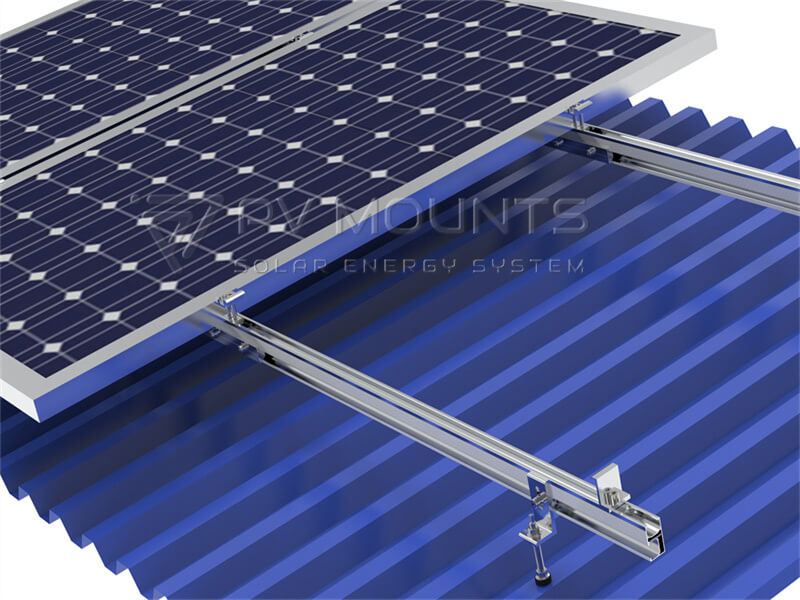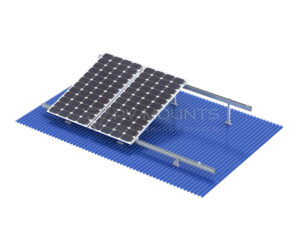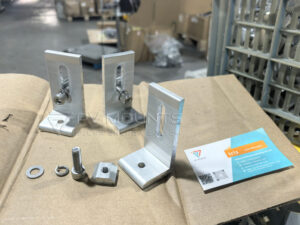Harnessing solar energy has never been more pivotal, and trapezoidal metal roof solar racking stands at the forefront of this green revolution. This article dives into the essence of integrating solar panels with trapezoidal metal roofs, offering insights into the mechanisms, benefits, and considerations that encapsulate this sustainable synergy.
Understanding Trapezoidal Metal Roof Solar Racking
Trapezoidal metal roofs, known for their strength and durability, offer an ideal landscape for solar panel installation. The unique geometry of these roofs provides ample surface area and optimal orientation for solar panels, enhancing energy capture efficiency.
The compatibility of trapezoidal metal roofs with solar racking systems is a testament to modern engineering ingenuity. These systems are specifically designed to latch onto the peaks and valleys of trapezoidal roofs, ensuring a secure and stable foundation for solar panels. This harmony between form and function not only optimizes solar energy production but also preserves the structural integrity of the roof.
The advent of trapezoidal metal roof solar racking has revolutionized the solar industry, providing a streamlined solution to the age-old challenge of efficient space utilization. By marrying the robustness of metal roofing with the renewable prowess of solar panels, this approach paves the way for a sustainable future, proving that indeed, where there’s a roof, there’s a renewable way.
Key Components of a Solar Mounting System
At the heart of every solar mounting system on trapezoidal roofs lie its key components, each playing a crucial role in the symphony of solar energy production. Rails, the backbone of the system, are meticulously aligned along the roof’s ridges, providing a sturdy foundation for the solar panels. Clamps, the unsung heroes, cling to the rails with tenacious grip, anchoring the panels in place and braving the elements to ensure stability.
Mounting brackets, the connective tissue between the panels and the roof, are engineered for resilience. They conform to the trapezoidal contours, ensuring that the panels are not only secure but also positioned to capture the optimum amount of sunlight. This trinity of components – rails, clamps, and mounting brackets – orchestrates the efficient conversion of sunlight into electricity, demonstrating that in the realm of solar energy, every piece plays a pivotal role.
The meticulous design of these components reflects a deep understanding of the challenges and opportunities presented by trapezoidal metal roofs. They embody the principles of strength, precision, and efficiency, which are crucial in harnessing the full potential of solar energy. Through this harmonious integration, solar mounting systems on trapezoidal roofs stand as a paragon of renewable energy innovation, turning every rooftop into a powerhouse of sustainability.
Design Considerations for Solar Panels on Trapezoidal Roofs
When it comes to outfitting trapezoidal roofs with solar panels, design considerations play a pivotal role. The unique shape of these roofs requires a thoughtful approach to ensure that the solar array not only fits aesthetically but also functions optimally. Orientation and tilt are crucial; they must be meticulously calculated to harness the sun’s rays most effectively. A south-facing orientation, for instance, maximizes sun exposure in the northern hemisphere, while the tilt angle should be adjusted to match the latitude of the location for optimal energy absorption.
Load distribution is another critical factor, as the weight of the solar panels must be evenly spread across the trapezoidal ridges to avoid structural stress. Moreover, the integration of solar technology should enhance, not compromise, the roof’s appearance and functionality. This delicate balance between form and function highlights the art and science of solar installations on trapezoidal roofs, showcasing the ingenuity required to merge renewable energy solutions with architectural integrity.
Installation Process of Solar Panels on Trapezoidal Roofs
The installation of solar panels on trapezoidal roofs is a journey of precision and expertise. It begins with a thorough assessment of the roof structure, followed by a detailed planning phase where the layout of the panels is meticulously designed to fit the unique contours of the trapezoidal roof. The installation process is a step-by-step dance, starting with the secure mounting of rails and brackets, ensuring that each component is perfectly aligned and anchored.
As the panels are positioned and secured, common challenges such as uneven surfaces or complex roof geometries are skillfully navigated. Installers must be adept at adapting their techniques to these challenges, ensuring that each panel is optimally placed for maximum solar capture. The process, while intricate, unfolds with a rhythm, culminating in a fully functional solar array that not only generates clean energy but also complements the roof’s design.
Maintaining Your Solar Panel System on a Trapezoidal Roof
Post-installation, the focus shifts to maintaining the solar panel system to ensure its longevity and efficiency. Routine checks are essential; they help in identifying and addressing issues like dust accumulation, shading, or wear and tear, which can affect performance. Cleaning the panels regularly is also crucial to remove debris that might block sunlight.
Moreover, maintenance isn’t just about preserving functionality; it’s also about sustaining efficiency. Repairs, when needed, should be executed promptly to prevent minor issues from escalating into major problems. This ongoing care not only prolongs the life of the solar system but also ensures that it continues to operate at peak efficiency, making maintenance a key chapter in the story of solar energy on trapezoidal roofs.
Cost Analysis of Installing Solar Panels on Trapezoidal Metal Roofs
The financial aspect of installing solar panels on trapezoidal metal roofs warrants a close examination. The initial cost may seem daunting, but it’s a long-term investment that pays dividends. Over time, the energy savings can offset the upfront expenses. Analyzing these costs involves comparing the price of installation, equipment, and maintenance with the expected energy savings and lifespan of the system.
Incentives and subsidies can significantly reduce the initial outlay. Many governments offer tax breaks, rebates, or grants to encourage solar energy adoption. These incentives can make solar installations much more affordable. Ultimately, the return on investment for solar panels on trapezoidal roofs is favorable, especially when considering the environmental benefits and the potential increase in property value.
Case Studies: Success Stories of Solar Mounting on Trapezoidal Roofs
Examining real-life applications illuminates the practical benefits of solar mounting systems on trapezoidal roofs. Residential case studies often reveal how homeowners achieve energy independence and significantly reduce their utility bills. Commercial examples highlight how businesses can enhance their sustainability credentials and lock in energy costs.
These success stories are not just about financial savings. They also showcase the technological reliability and durability of solar systems on trapezoidal roofs. By analyzing these cases, potential adopters can gain insights into the long-term benefits and performance of solar installations in various settings.
Latest Innovations in Trapezoidal Metal Roof Solar Racking
The solar industry is constantly evolving, with innovations enhancing the efficiency and integration of solar systems on trapezoidal roofs. Technological advancements have led to more robust and flexible racking systems. These improvements facilitate easier installation and better integration with roofing materials.
Future trends point towards even more sophisticated solar solutions. These include building-integrated photovoltaics (BIPV) and smart solar systems. Such innovations promise to further streamline solar installations on trapezoidal roofs. They will make solar energy more accessible and appealing to a broader audience.
Choosing the Right Solar Mounting System for Your Trapezoidal Roof
Selecting the appropriate solar mounting system is crucial. Factors like roof size, angle, and material play a key role. It’s important to consider the local climate and potential shading issues as well. Consulting with experts ensures the chosen system fits the specific needs of the trapezoidal roof. They can guide through options and recommend the best solution.
FAQs about Solar Mounting Systems on Trapezoidal Roofs
- How do trapezoidal roofs affect solar panel efficiency? Trapezoidal roofs can enhance efficiency due to their shape, allowing optimal panel placement.
- Can any solar panel be installed on a trapezoidal roof? Yes, but the mounting system must be compatible with the roof’s design and load capacity.
- What is the lifespan of a solar mounting system on a trapezoidal roof? Typically, these systems last 25-30 years, mirroring the lifespan of solar panels.
- How does weather impact solar installations on trapezoidal roofs? Properly installed systems withstand various weather conditions, ensuring durability and performance.
- Are there specific maintenance requirements for these solar systems? Regular cleaning and occasional inspections are necessary to maintain efficiency and longevity.
- Can I install a solar system on an old trapezoidal roof? Yes, but a roof assessment is essential to ensure it can support the solar system.
Conclusion and Future Outlook
Solar mounting systems on trapezoidal roofs represent a smart investment in renewable energy. They combine functionality, efficiency, and sustainability. As technology advances, these systems will become more integrated and efficient. The future is bright for solar energy on trapezoidal roofs, promising a cleaner, greener planet.













